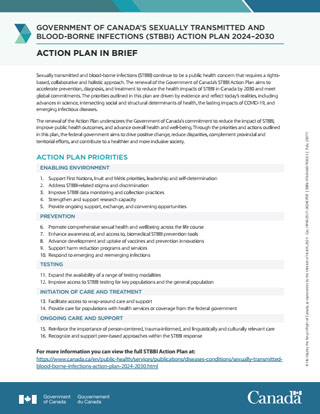Government of Canada's sexually transmitted and blood-borne infections (STBBI) action plan 2024-2030 in brief

- Organization: Public Health Agency of Canada
- Date published: February 2024
Action plan in brief
Sexually transmitted and blood borne infections (STBBI) continue to be a public health concern that requires a rights-based, collaborative and holistic approach. The renewal of the Government of Canada's STBBI Action Plan aims to accelerate prevention, diagnosis, and treatment to reduce the health impacts of STBBI in Canada by 2030 and meet global commitments. The priorities outlined in this plan are driven by evidence and reflect today's realities, including advances in science, intersecting social and structural determinants of health, the lasting impacts of COVID-19, and emerging infectious diseases.
The renewal of the Action Plan underscores the Government of Canada's commitment to reduce the impact of STBBI, improve public health outcomes, and advance overall health and well-being. Through the priorities and actions outlined in this plan, the federal government aims to drive positive change, reduce disparities, complement provincial and territorial efforts, and contribute to a healthier and more inclusive society.
Action plan priorities
Enabling Environment
- Support First Nations, Inuit and Métis priorities, leadership and self-determination
- Address STBBI-related stigma and discrimination
- Improve STBBI data monitoring and collection practices
- Strengthen and support research capacity
- Provide ongoing support, exchange, and convening opportunities
Prevention
- Promote comprehensive sexual health and wellbeing across the life course
- Enhance awareness of, and access to, biomedical STBBI prevention tools
- Advance development and uptake of vaccines and prevention innovations
- Support harm reduction programs and services
- Respond to emerging and reemerging infections
Testing
- Expand the availability of a range of testing modalities
- Improve access to STBBI testing for key populations and the general population
Initiation of Care and Treatment
- Facilitate access to wrap-around care and support
- Provide care for populations with health services or coverage from the federal government
Ongoing Care and Support
- Reinforce the importance of person-centered, trauma-informed, and linguistically and culturally relevant care
- Recognize and support peer-based approaches within the STBBI response